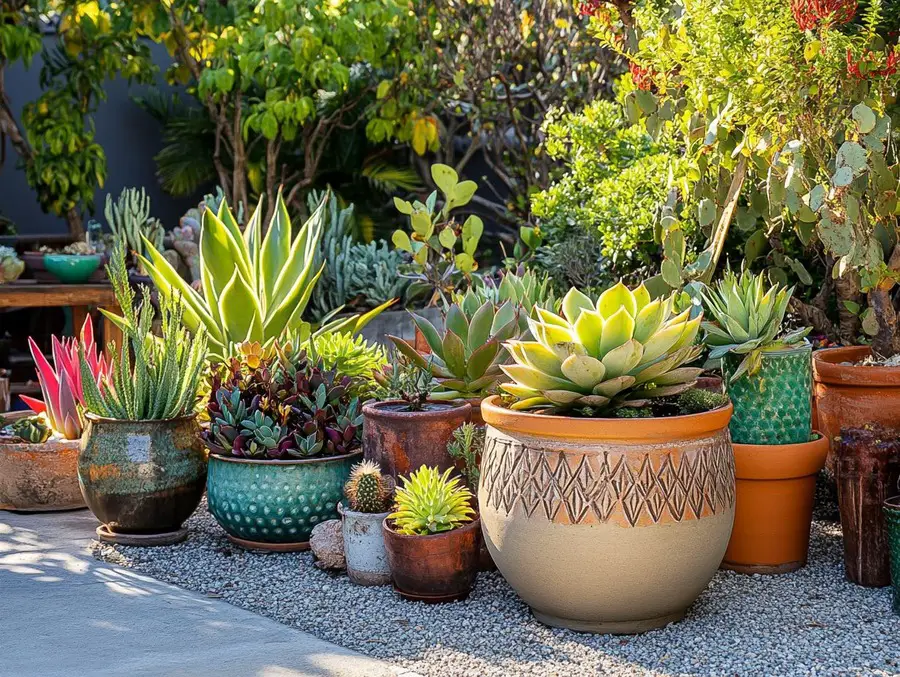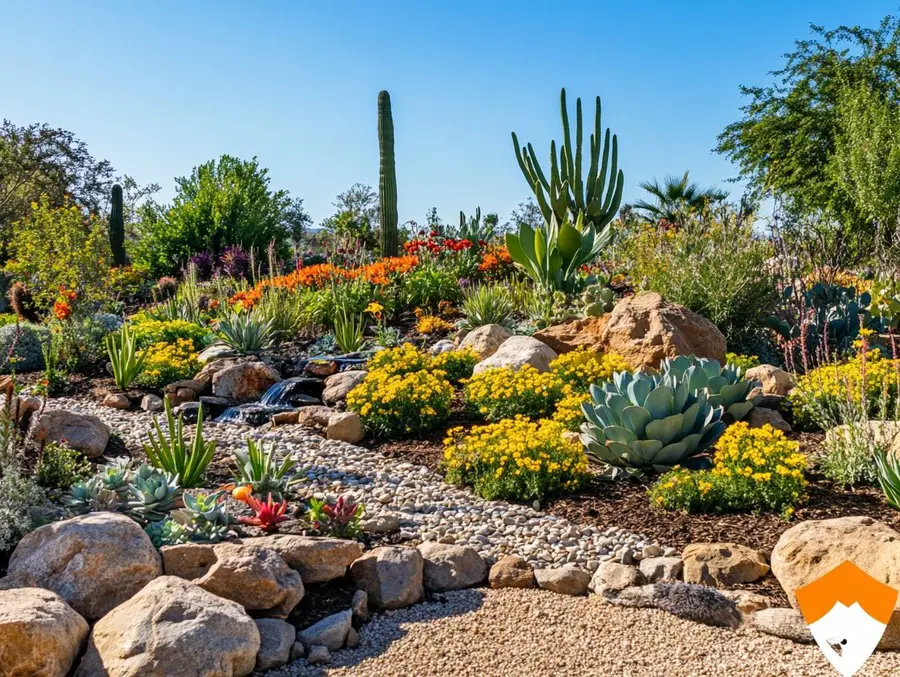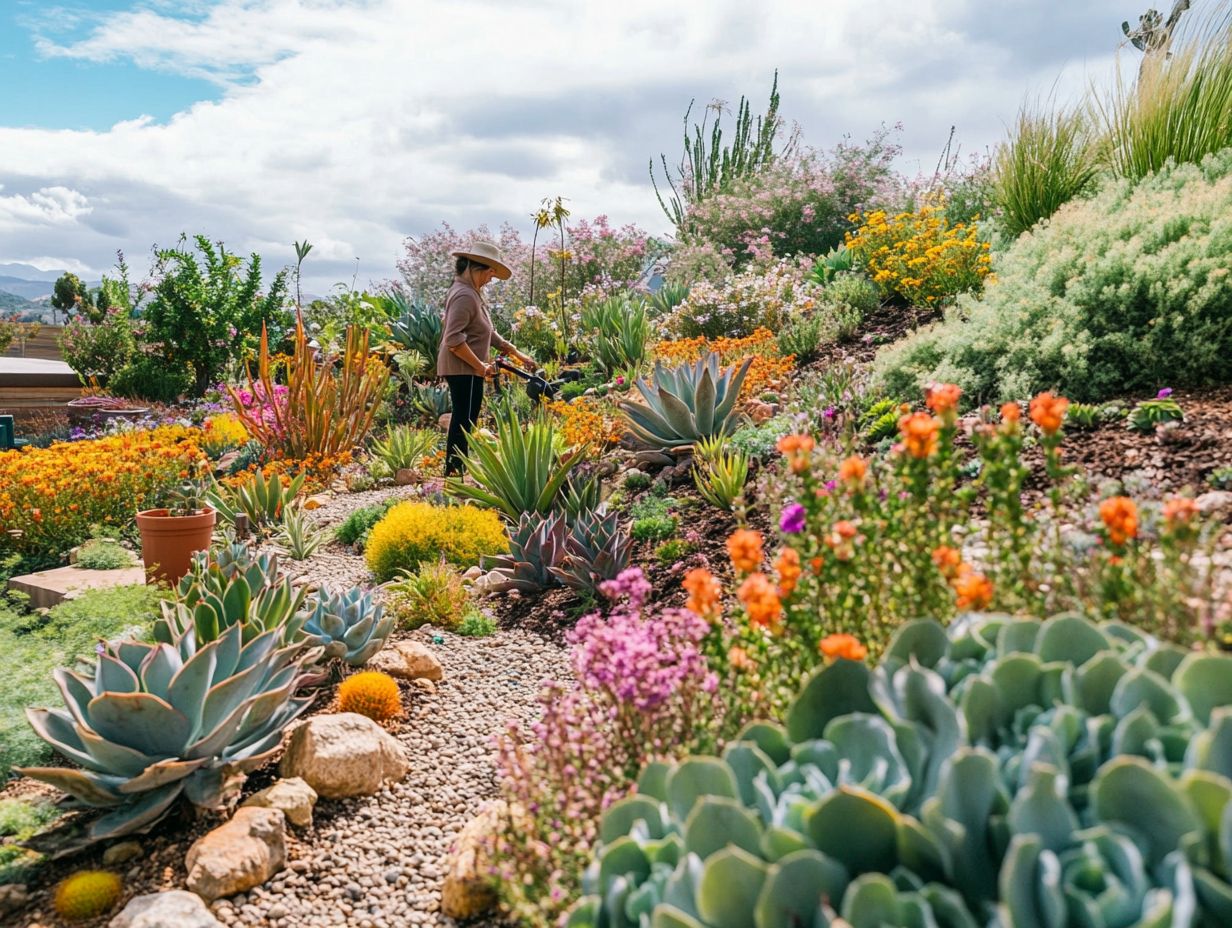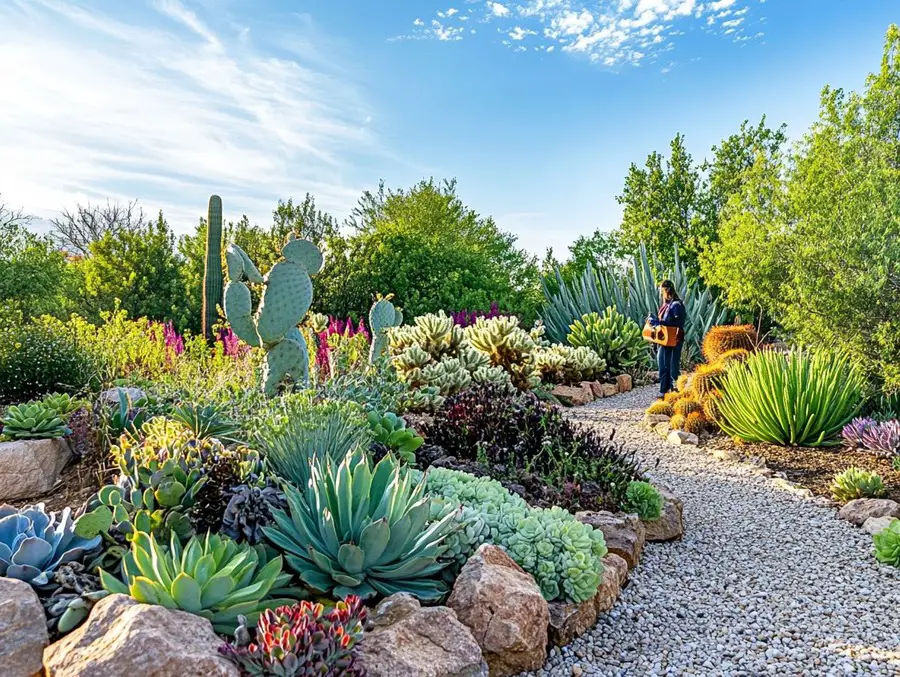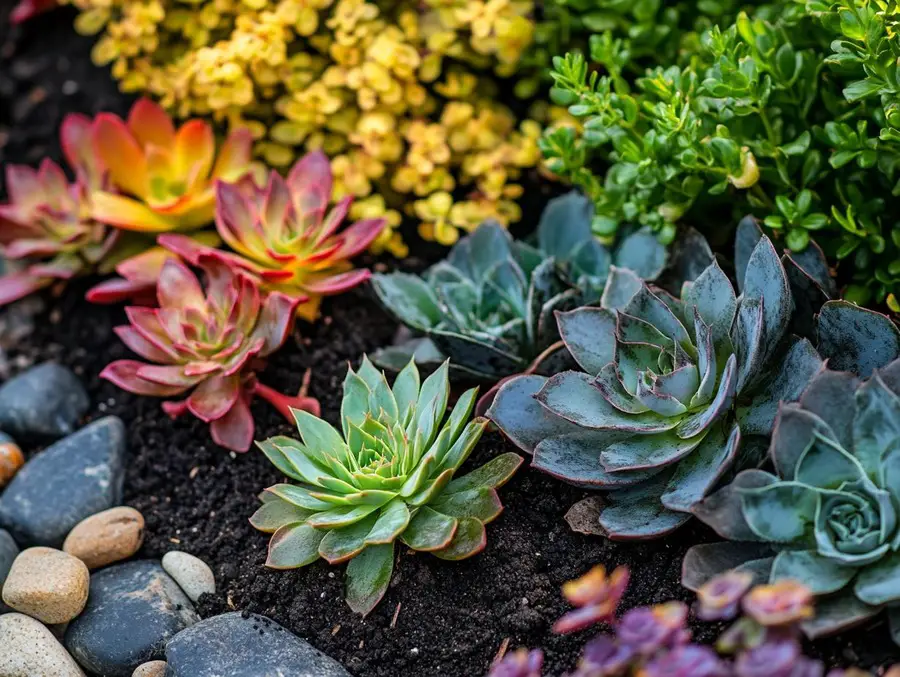We use affiliate links. If you purchase something using one of these links, we may receive compensation or commission.

Dive into how to start a rooftop garden with our guide. Transform your urban space into a lush oasis. Helpful tips inside!
Starting A Rooftop Garden Key Takeaways:
- To start a rooftop garden, first, check your roof’s capacity to ensure it can support the weight.
- Choose lightweight containers and drought-tolerant plants suited for high exposure to sun and wind.
- Set up an efficient watering system. Begin with herbs and vegetables for a rewarding, edible garden.
Ever wondered how to start a rooftop garden? You’re in the right place!
Transform your rooftop into a green paradise with our easy, step-by-step guide on how.
Let’s create a beautiful, sustainable space together, one plant at a time. Join us as we embark on a journey to green our urban environments.
Introduction to Rooftop Gardening
Starting a rooftop garden is a fantastic way to utilize urban spaces for greenery, offering benefits like pest resistance, less weeding, and creating a personal oasis.
A Green Revolution Above:
Rooftop gardening is transforming unused urban spaces into vibrant green areas.
It’s not just about adding a splash of color; it’s about creating eco-friendly spaces that bring nature back into the city.
As cities grow, so does the popularity of rooftop gardens, offering a fresh perspective on urban living.
Why Rooftop Gardens?:
They provide a list of benefits that extend beyond beauty.
They help cool down buildings, reduce air pollution, and even offer fresh produce right in the heart of the city.
It’s a smart way to utilize space efficiently and sustainably.
Urban Oasis Creation:
In bustling cities, rooftop gardens are becoming essential retreats for residents seeking tranquility and a touch of nature.
Whether it’s growing your own vegetables or creating a cozy space to unwind, rooftop gardens offer a personal haven above the city’s hustle.
The Growing Trend:
The interest in rooftop gardening is on the rise, as people search for innovative ways to incorporate greenery into urban environments.
It’s a movement towards more sustainable living, where every rooftop has the potential to become a garden.
Benefits of Rooftop Gardening

Rooftop gardens transform unused urban spaces into lush, green sanctuaries, offering a myriad of benefits that enrich our environment
Rooftop Gardening Ideas
Transforming your rooftop into a garden is not just about adding greenery; it’s about creating a unique space that reflects personal taste and maximizes urban outdoor living.
Whether it’s a tranquil Zen retreat, a vibrant ecosystem for pollinators, or a sleek modern design, the right ideas can turn any rooftop into a stunning and sustainable garden.
Explore these innovative concepts to discover how smart layout choices and thoughtful plant selection can elevate your rooftop gardening project.
Creating Your Sky-High Paradise:
Rooftop gardening opens up a world of creativity and innovation.
From serene Zen gardens that provide a peaceful retreat to bustling pollinator-friendly spaces that support local wildlife, the possibilities are endless.
Let’s dive into how you can transform your rooftop into a green sanctuary.
Zen Gardens Above the City:
Imagine a space where simplicity and nature blend seamlessly.
Zen rooftop gardens use elements like stones, water features, and minimalist plant selections to create a tranquil escape.
This design is perfect for meditation and relaxation.
Pollinator-Friendly Havens:
By choosing plants that attract bees, butterflies, and other pollinators, your rooftop can contribute to the local ecosystem’s health.
Think vibrant flowers, native shrubs, and herbs. Not only does this support biodiversity, but it also brings a burst of life and color to your garden.
Modern Minimalist Designs:
For those who love sleek, contemporary looks, a modern minimalist rooftop garden might be the way to go.
Utilize clean lines, geometric shapes in planters and furniture, and a monochromatic color palette with strategic pops of green.
This style emphasizes simplicity and open space, making your rooftop feel larger and more open.
Maximizing Space and Aesthetics:
Smart layout and plant selection are key to making your own rooftop garden truly your own.
Vertical gardening, for example, is a fantastic way to save space while growing a variety of plants.
Incorporating multi-functional furniture and built-in planters can enhance usability without sacrificing style.
Personal Touches:
Ultimately, your rooftop garden should reflect your personal style and needs.
Whether it’s a cozy nook for reading, a space for outdoor dining, or a full-blown vegetable garden, adding personal touches will make it uniquely yours.
By exploring these rooftop gardening ideas, you can turn any blank rooftop into a lush, inviting outdoor living space that not only looks stunning but also provides environmental benefits.
Rooftop Vegetable Garden
A rooftop vegetable garden brings the joy of homegrown produce to urban living, blending functionality with aesthetic appeal.
This space can be a source of fresh vegetables, herbs, and fruits, turning a barren rooftop into a lush, productive oasis.
Here’s how to ensure your rooftop vegetable garden thrives:
Choosing the Right Containers:
Opt for deep containers that accommodate the root growth of your chosen vegetables. Lightweight materials like plastic or fabric pots are ideal, and ensure they have adequate drainage.
Selecting Suitable Crops:
Focus on vegetables that thrive in your climate and sunlight conditions.
Leafy greens, tomatoes, peppers, and herbs are excellent choices for rooftop gardens.
Consider the weight and spacing requirements of larger plants like squash or melons if your structure can support them.
Sunlight and Water:
Most vegetables need at least 6-8 hours of direct sunlight daily. If your rooftop has partial shade, choose shade-tolerant crops like lettuce or spinach.
Set up a watering system that keeps the soil consistently moist, crucial for vegetable growth.
Soil and Nutrition:
Use a high-quality potting mix designed for container gardening, enriched with compost to provide the nutrients your vegetables need to flourish.
Coco coir is a lighter alternative to potting soil and provides excellent drainage and aeration.
Regularly check and balance the soil’s pH level according to the needs of your plants.
Visual Appeal and Functionality:
Integrate your vegetable containers into an attractive design that maximizes space.
Use vertical planters for vines like tomatoes and cucumbers. Add flowering plants to attract pollinators and enhance the garden’s beauty.
By considering these factors, your rooftop can transform into a thriving vegetable garden, providing fresh produce and a beautiful green space atop your urban home.
Problems with Rooftop Gardens
While rooftop gardens offer numerous benefits, they also come with their own set of challenges.
Understanding these hurdles is key to creating a successful and sustainable rooftop oasis.
- Weight Restrictions: One of the primary concerns is the weight capacity of the roof. Overloading can risk structural damage.
- Solution: Consult with a structural engineer and opt for lightweight materials and soil alternatives.
- Wind Exposure: Rooftops are more exposed to wind, which can harm plants and dry out soil quickly.
- Solution: Use windbreaks such as trellises, install sturdy containers, and select wind-resistant plant varieties.
- Water Drainage: Proper drainage is crucial to prevent waterlogging and potential damage to the building.
- Solution: Ensure your garden design includes adequate drainage solutions, such as raised beds and drainage layers beneath soil.
- Legal Considerations: There may be zoning laws, building codes, or HOA regulations affecting rooftop gardening. Solution: Before starting, check with local authorities and your building management to ensure compliance with all regulations.
Getting Started with Your Rooftop Garden
Securing Permission and Laying Plans:
Before you break ground, or rather, head up, getting the green light from your landlord or condo board is crucial.
This initial step ensures your garden is on solid legal ground.
From there, the planning phase involves choosing between raised beds, which can offer better drainage and soil conditions, or containers, which are versatile and mobile.
Each has its benefits depending on your garden goals and rooftop conditions.
Measuring Up and Designing Your Space:
Knowing exactly how much space you have is key. Grab a tape measure and make a detailed note of your rooftop’s dimensions.
This will help in sketching a garden design that fits your space perfectly.
For those new to garden planning, there are plenty of online tutorials and ready-made plans that can guide you in setting up either raised beds or container gardens.
These resources can be invaluable in avoiding common pitfalls and making the most of your available space.
By carefully navigating these initial steps, you’re laying the groundwork for a rooftop garden that’s not just possible, but also productive and pleasing to the eye.
Choosing the Right Containers
Creating a rooftop garden in urban settings brings its own set of challenges, with container choice being a pivotal decision for gardeners.
The selection of containers—be it plastic, fiberglass, terra cotta, or ceramic—plays a critical role in the success and management of these green spaces.
Each material offers distinct advantages in terms of weight, cost, and mobility, making them particularly suitable for renters and those with space constraints.
This introduction sets the stage for a deeper exploration into how choosing the right container can influence the health of your plants and the overall aesthetic of your rooftop garden.
The Perfect Fit for Urban Green Spaces:
When planning a rooftop garden, choosing the right type of container is crucial.
Options like plastic, fiberglass, terra cotta, and ceramic offer unique benefits that cater to the needs of urban gardeners, especially renters.
Lightweight and Versatile:
Plastic and fiberglass containers are light, making them easy to move around.
This flexibility is essential for adjusting layout or accommodating seasonal changes, ideal for rooftop conditions where weight and distribution matter.
Affordability Meets Style:
Both terra cotta and fabric containers provide an economical yet aesthetically pleasing solution.
Their affordability ensures that starting a garden is accessible, while their variety of designs can enhance the visual appeal of your space.
Portability for the Urban Gardener:
The ease of moving these containers makes them perfect for renters or those who like to change their garden layout.
This mobility also allows for optimizing plant exposure to sunlight and accommodating any rooftop regulations or structural limitations.
By carefully selecting containers based on these advantages, you can create a functional, beautiful, and thriving rooftop garden tailored to urban living requirements.
Selecting Suitable Plants
Creating a thriving rooftop garden means choosing plants carefully.
Rooftop conditions such as strong sunlight, wind, and limited soil depth pose unique challenges but also offer unique opportunities.
Here’s how to navigate these conditions with smart plant choices:
- Thriving in the Sun and Wind: Look for plants known for their resilience. Drought-tolerant species, certain vegetables, and wind-resistant decorative plants can all flourish in rooftop environments.
- Drought-Tolerant Wonders: Succulents, lavender, and sedum are excellent choices that require minimal water, making them perfect for the sunny rooftop setting.
- Vegetables for the Urban Farmer: Tomatoes and strawberries are not only adaptable to containers but also thrive in full sun, making them ideal for a rooftop vegetable garden.
- Wind-Resilient Decoratives: Ornamental grasses and certain shrubs have the strength to withstand windy conditions and can add both beauty and a natural windbreak to your garden space.
- Selecting the right plants is crucial for a rooftop garden’s success, blending aesthetics with the practicalities of urban gardening.
Irrigation Solutions
Ensuring Adequate Water for Your Rooftop Garden
Maintaining a healthy rooftop garden requires consistent watering strategies to combat the unique challenges of elevated exposure and the potential for quicker soil dryness.
Implementing effective irrigation solutions can significantly ease maintenance efforts and ensure your plants thrive.
Automatic Watering Systems:
An automatic system can deliver water directly to your plants at set intervals, ensuring they receive consistent moisture even in your absence.
This is particularly useful for busy gardeners or during hot weather when plants need more frequent watering.
Self-Watering Containers:
These containers are designed to allow plants to draw water as needed from a reservoir, reducing the frequency of manual watering and ensuring plants have access to water even if you’re away for a few days.
Drip Irrigation:
A drip irrigation setup is ideal for targeted watering, delivering moisture directly to the base of each plant.
This method conserves water and is efficient for larger rooftop gardens.
Incorporating these irrigation solutions can greatly enhance the sustainability and ease of maintaining a rooftop garden, allowing you to enjoy a lush, thriving green space without the constant worry of watering.
Tools and Maintenance
For a rooftop garden to flourish, having the right tools on hand and a consistent maintenance routine is key.
This ensures your garden not only survives but thrives, contributing to both the health of your plants and the overall aesthetics of your garden space.
Essential Gardening Tools:
Begin with the basics – a watering can or hose attachment for precise irrigation, durable gloves for protection, a trowel for planting and potting, and shears for pruning and shaping your plants.
Lightweight and versatile tools are preferred for the rooftop setting to make gardening tasks easier and more efficient.
Soil Health and Fertilization:
Regularly check your soil’s moisture and nutrient levels. A portable soil tester can be a valuable tool for this purpose.
Depending on your plants’ needs, incorporate a balanced fertilizer to keep your garden vibrant and productive.
Pest and Disease Management:
Keep an eye out for signs of pests and diseases. Handheld sprayers can be useful for applying organic pesticides or fungicides, ensuring your plants stay healthy without harming the environment.
Aesthetic Upkeep:
To maintain the visual appeal of your garden, invest in tools like a small rake for tidying up the soil surface and a broom for keeping pathways and surfaces clean.
By equipping yourself with these essential tools and following maintenance tips, you can ensure your rooftop garden remains a beautiful and bountiful sanctuary amidst the urban landscape.
Related Content
Visit my Amazon Influencer Page for videos and gardening products Grow Your Own Garden




